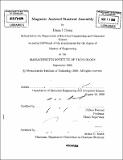| dc.contributor.advisor | Clifton Fonstad. | en_US |
| dc.contributor.author | Cheng, Diana I | en_US |
| dc.contributor.other | Massachusetts Institute of Technology. Dept. of Electrical Engineering and Computer Science. | en_US |
| dc.date.accessioned | 2009-06-30T16:58:04Z | |
| dc.date.available | 2009-06-30T16:58:04Z | |
| dc.date.copyright | 2008 | en_US |
| dc.date.issued | 2008 | en_US |
| dc.identifier.uri | http://hdl.handle.net/1721.1/45999 | |
| dc.description | Thesis (M. Eng.)--Massachusetts Institute of Technology, Dept. of Electrical Engineering and Computer Science, 2008. | en_US |
| dc.description | Includes bibliographical references (p. 87). | en_US |
| dc.description.abstract | The objective of this thesis is to develop a process using magnetic forces to assemble micro-components into recesses on silicon based integrated circuits. Patterned SmCo magnetic thin films at the bottom of recesses are used to provide forces to orient, align and retain micro-devices on silicon. The overall objective is to obtain functionalities not readily available from silicon device structures alone. This thesis was done in the context of assembling optoelectronic devices, specifically integrating vertical cavity surface emitting lasers (VCSELs), edge-emitting lasers (EELs), and light emitting diodes(LEDs) onto commercially processed Si-CMOS circuits. This method, magnetically assisted statistical assembly (MASA), incorporates past methods such as Fluidic Assisted Self- Assembly (FASA) and Recess Mounting with Monolithic Metalization (RM3). Specifically, MASA addresses the main limitation to the FASA method by adding a magnetic layer as a restraint to keep assembled components correctly positioned in recesses until the time bonding may occur. Thus, all components may be permanently bonded into place simultaneously saving both time and money. This thesis will present simulations using Ansoft's Maxwell 3d providing general behavioral intuition for the behavior of a device over a target magnetic substrate. These results include using a rectangle instead of a circular disc and making recess depths greater than 2pm to overcome gravitational forces when inverting the substrate. Patterns of SmCo magnetic material, based on results from the simulations, included 50x100[mu]m recesses containing either a solid rectangle, thirty 5x10[mu]m rectangular pads, eighteen 5x10m rectangular pads or four 5x10m rectangular pads. | en_US |
| dc.description.abstract | (cont.) Patterns of SmCo material also were experimented with using 50x50 [mu]m square recesses containing either a solid square or nine 5x5[mu]m square pads. Experiments with various rectangular patterns showed evidence that upside down devices do not retain as well as right side up devices. It was also seen that four 5xl0[mu]m rectangular pads did not have enough magnetic material to retain even right side up devices. Solid rectangular patterns were also determined to have too much magnetic material to align and orient the device without recesses. Once recesses were added to the experiments, the pattern with thirty 5x10m rectangles proved to assemble the most devices with an assembly ratio of 90%. However problems occurred with fabricating perfect device shapes and thus mis-shapened devices were counted in the assembly ratio. Results from experimenting with square patterns with recesses show a 88% assembly ratio with a solid square pattern. This may be due to the symmetry of the square devices and therefore has higher probability of assembly than that of the rectangular devices. | en_US |
| dc.description.statementofresponsibility | by Diana I. Cheng. | en_US |
| dc.format.extent | 87 p. | en_US |
| dc.language.iso | eng | en_US |
| dc.publisher | Massachusetts Institute of Technology | en_US |
| dc.rights | M.I.T. theses are protected by
copyright. They may be viewed from this source for any purpose, but
reproduction or distribution in any format is prohibited without written
permission. See provided URL for inquiries about permission. | en_US |
| dc.rights.uri | http://dspace.mit.edu/handle/1721.1/7582 | en_US |
| dc.subject | Electrical Engineering and Computer Science. | en_US |
| dc.title | Magnetic assisted statistical assembly | en_US |
| dc.type | Thesis | en_US |
| dc.description.degree | M.Eng. | en_US |
| dc.contributor.department | Massachusetts Institute of Technology. Department of Electrical Engineering and Computer Science | |
| dc.identifier.oclc | 351812543 | en_US |
